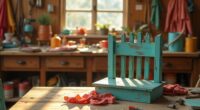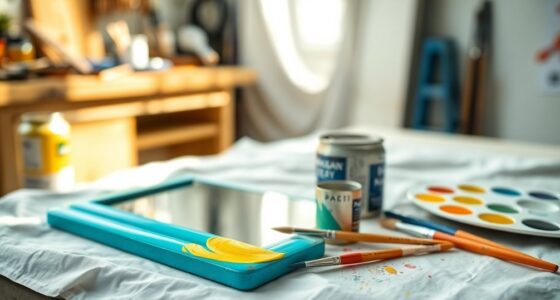To kick off your first DIY project, start by choosing something manageable that matches your skill level. Do some research and plan your steps carefully. Make sure you’ve got the right tools, like a tape measure and a saw, and consider your materials based on project needs. Set up a clean, organized workspace to stay focused. Most importantly, execute your plan methodically, and don’t forget to celebrate your success! Discover more tips and techniques as you go!
Key Takeaways
- Choose a manageable DIY project that suits your skill level and available resources to avoid frustration.
- Plan your project by defining goals, researching materials, and breaking tasks into smaller, achievable steps.
- Gather essential tools, starting with basic hand tools and considering any necessary power tools for efficiency.
- Set up a clutter-free, well-lit workspace that promotes organization and creativity while ensuring safety and comfort.
- Monitor your progress and maintain clear communication with any collaborators to enhance teamwork and project success.
Choose Manageable Projects
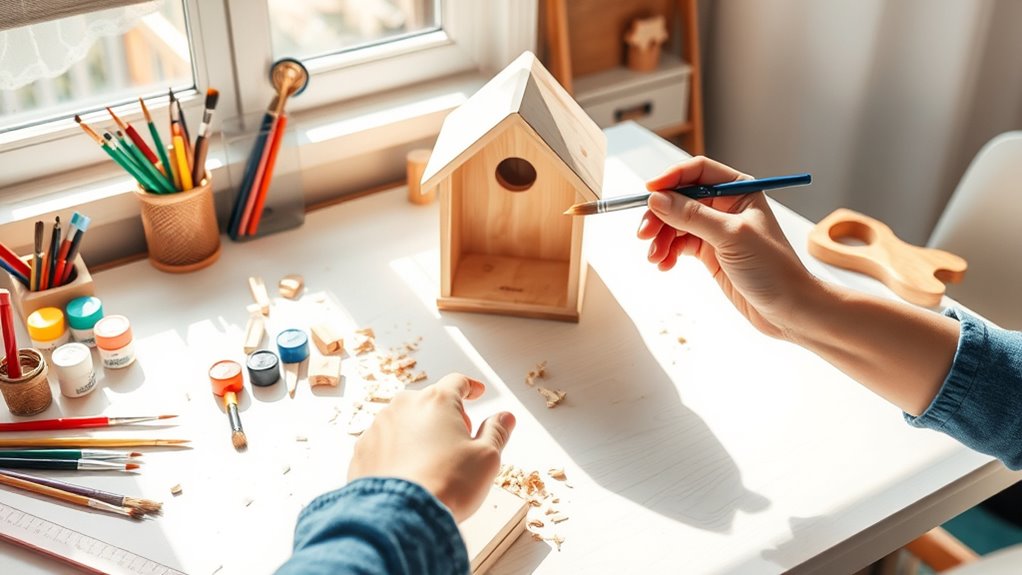
When embarking on DIY projects, it’s essential to choose ones that are manageable for your skill level and resources. Start with simple woodworking projects like DIY hanging plant holders or coasters made from wooden pieces. These require minimal materials and basic tools, making them perfect for beginners.
Assess your skills honestly; choose projects that match your current abilities to avoid frustration. Consider affordable materials like plywood or reclaimed wood to keep costs down. Breaking larger projects into smaller tasks and setting realistic timelines based on your schedule can lead to greater satisfaction. Simplifying designs can also help, ensuring you enjoy the process without feeling overwhelmed. Prioritize projects with clear instructions to boost your confidence and creativity as you engage. Additionally, incorporating unique and wicked planters into your DIY projects can enhance both aesthetics and functionality, allowing for a more vibrant indoor gardening experience. Adding handcrafted decor items can also reflect your individuality and personal style in your creations. For instance, using natural materials like wood and stone in your projects can elevate the overall design and bring a rustic charm reminiscent of modern farmhouse aesthetics. To further enhance your DIY experience, consider assessing bathroom needs to ensure that any renovations or updates you undertake align with your space’s functionality and flow. Engaging in these projects not only fosters creativity but also promotes mindfulness through decluttering, enhancing your overall emotional well-being as you create your own space.
Planning and Research
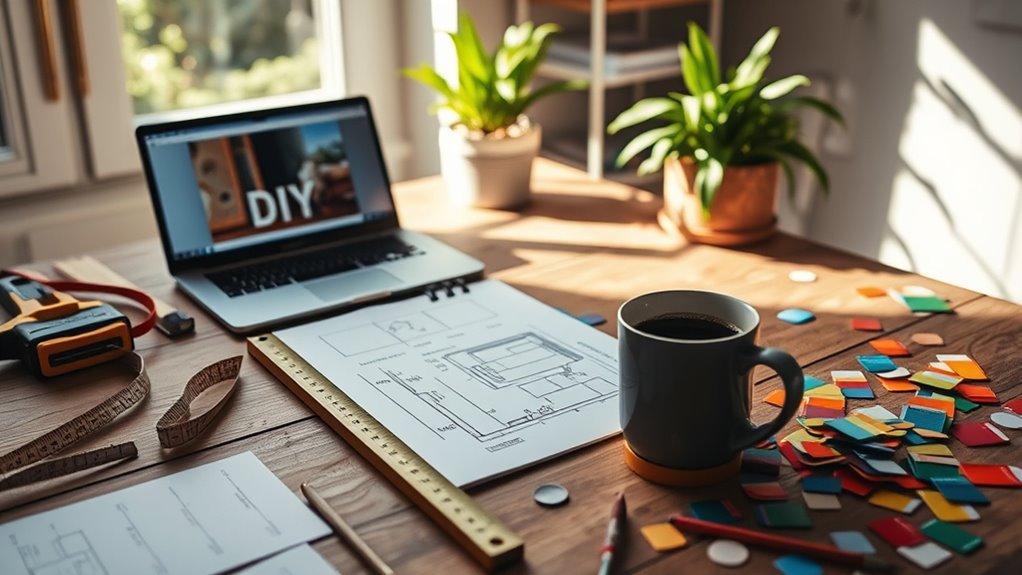
Effective planning and research lay the foundation for a successful DIY project. Start by defining your research area and developing a specific research question to guide your efforts. Anticipate your goals and the data you’ll need, ensuring your methods align with these objectives.
Assess the feasibility of your project, considering the time, budget, resources, and skills at your disposal. Regularly reviewing quality assurance metrics can help you gauge the effectiveness of your project planning. Review existing literature to frame your approach and gain insights from previous work, including emerging trends that may inform your project’s direction. For instance, understanding the importance of low light office plants can inspire creative ideas for your DIY project environment. Organize your materials efficiently to maintain a clean workspace and plan for potential challenges. Understanding color accuracy can significantly enhance the quality of your DIY projector screen project. Additionally, setting specific savings goals can help you manage your budget effectively throughout the project.
Tool Selection
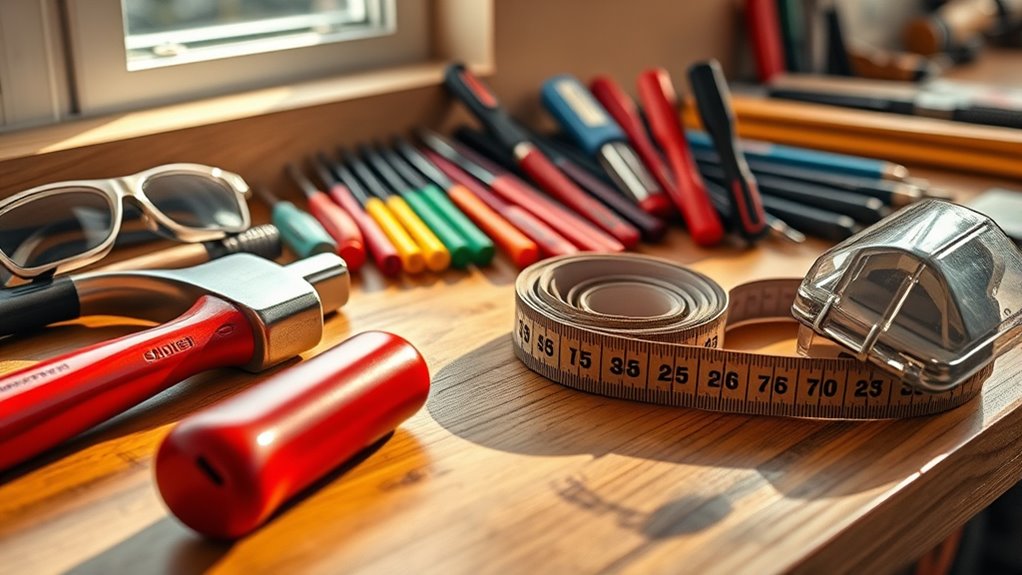
After laying a solid foundation through planning and research, the next step is selecting the right tools for your DIY project.
Start with basic hand tools like a 25′ tape measure, a claw hammer, pliers, a magnetized screwdriver set, and a Stanley knife. For power tools, consider a drill with bits, a brad nailer, an orbital sander, and a glue gun for quick fixes. Having the right safety features can help prevent accidents while using power tools. Additionally, using tools with proper airflow can enhance safety and efficiency during your project. It’s also important to consider solar charge controllers if your DIY project involves integrating solar energy solutions. A clean workspace can also support a healthier lifestyle by reducing stress and improving focus.
Begin your DIY journey with essential hand tools and reliable power tools for efficiency and precision.
Don’t forget specialized tools like a caulking gun and a spirit level for precision. Safety is key, so grab safety goggles and a work light.
Finally, invest in quality tools and maintain them regularly to guarantee they last. A well-organized toolbox and workbench will keep you efficient and focused on your project. Additionally, having the right dust removal vacuum can help keep your workspace clean and free from debris during your DIY endeavors.
Material Selection
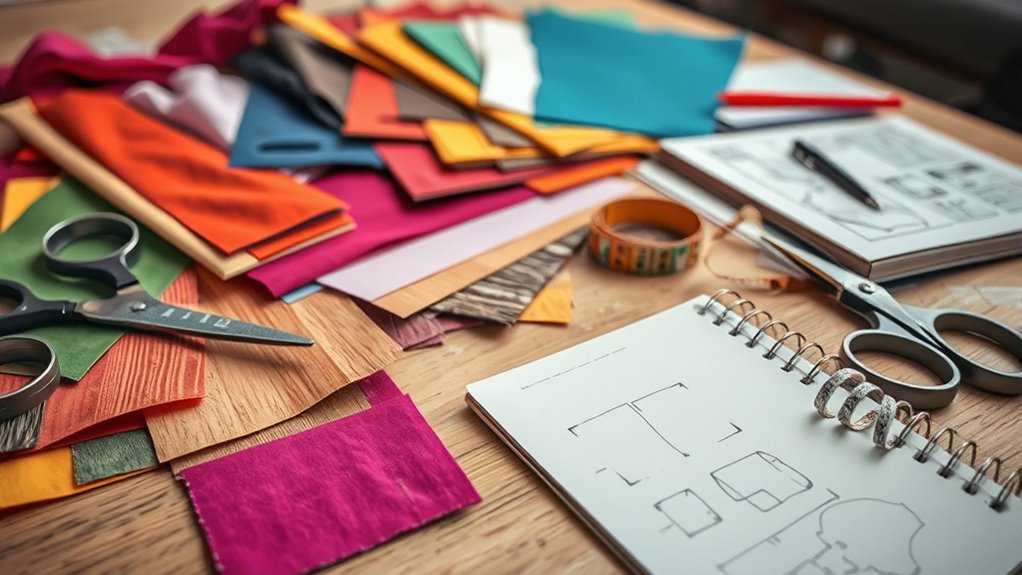
Selecting the right materials is essential for any DIY project, as it directly impacts the quality, durability, and overall success of your work.
Start by identifying the project’s nature—whether it’s structural, decorative, or functional. Consider the material properties like strength, weather resistance, and durability. Aesthetic appeal matters too; think about color and texture. For instance, incorporating natural elements like wood and stone can enhance the visual appeal and create a soothing atmosphere. Additionally, understanding filial responsibility laws can help inform your decision-making if the project involves family considerations. Many homesteaders also focus on using sustainable materials that promote eco-friendliness in their creations. Choosing the best woods for your project, such as oak or maple, can significantly elevate the quality of your work.
Balance your choices with budget constraints, guaranteeing you get quality without overspending. Check material availability to avoid delays.
Common materials include versatile wood, flexible plastics, and elegant glass. For specific uses, MDF is perfect for smooth finishes, while plywood offers cost-effective solutions. Additionally, consider integrating smart home devices into your project to enhance functionality and convenience.
Always consider sustainability and maintenance needs to guarantee longevity in your DIY creations.
Workspace Setup
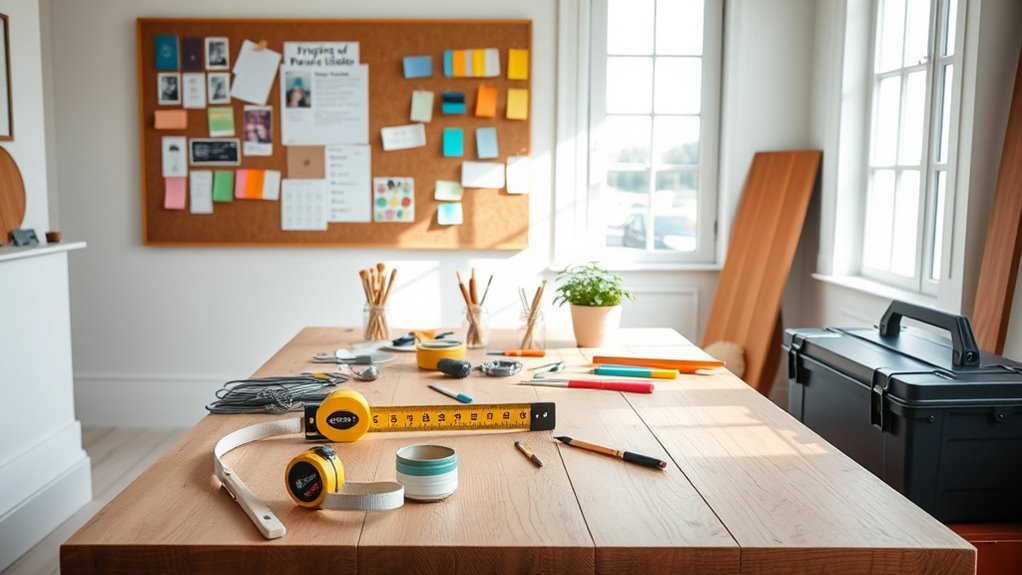
Creating an organized workspace is essential for a successful DIY project, as it sets the stage for efficient and enjoyable work.
Start by clearing a workbench or table to keep tools and materials within easy reach. A clutter-free environment boosts your efficiency and enhances focus. Incorporating best DIY home security systems can provide peace of mind while you work on your projects. An organized space can also help you maximize space by ensuring that every item has its designated spot. Additionally, consider setting up your workspace to accommodate Volkswagen Tuning enthusiasts who may need a space for tools and parts.
Make certain your workspace is well-lit; use task lighting for specific areas and consider natural light to improve visibility and mood.
Ergonomics matter too—set up your space to avoid strain, using adjustable heights and comfortable seating.
Finally, don’t forget safety: wear protective gear and guarantee good ventilation. Incorporating weather-resistant materials can also enhance the longevity of your workspace setup.
With these elements in place, you’ll have a workspace that inspires creativity and productivity.
Project Execution
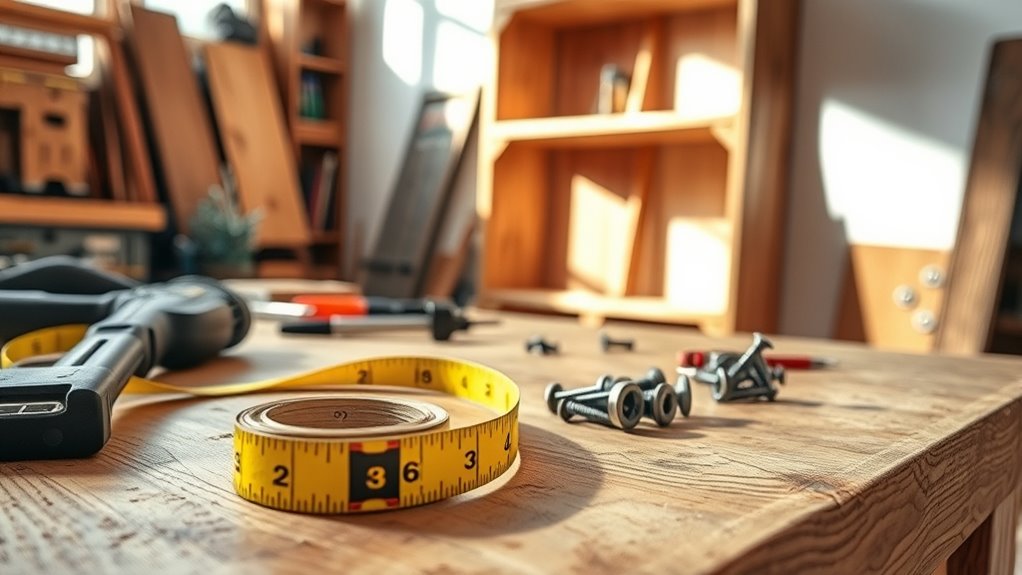
With your organized workspace ready, it’s time to focus on project execution. Start by clearly defining your deliverables and creating a Project Execution Plan (PEP) to outline tasks and milestones.
Use project management software like Smartsheet to manage resources and track progress efficiently. Monitor timelines with Gantt charts, adjusting as needed to avoid scope creep.
Clear communication is essential; keep stakeholders updated and seek their feedback regularly. Encourage team enthusiasm by delegating tasks based on individual strengths.
Don’t forget about risk management; identify potential issues early and develop strategies to mitigate them. By staying organized and proactive, you’ll navigate challenges effectively and keep your DIY project on track.
Celebrate Your Success
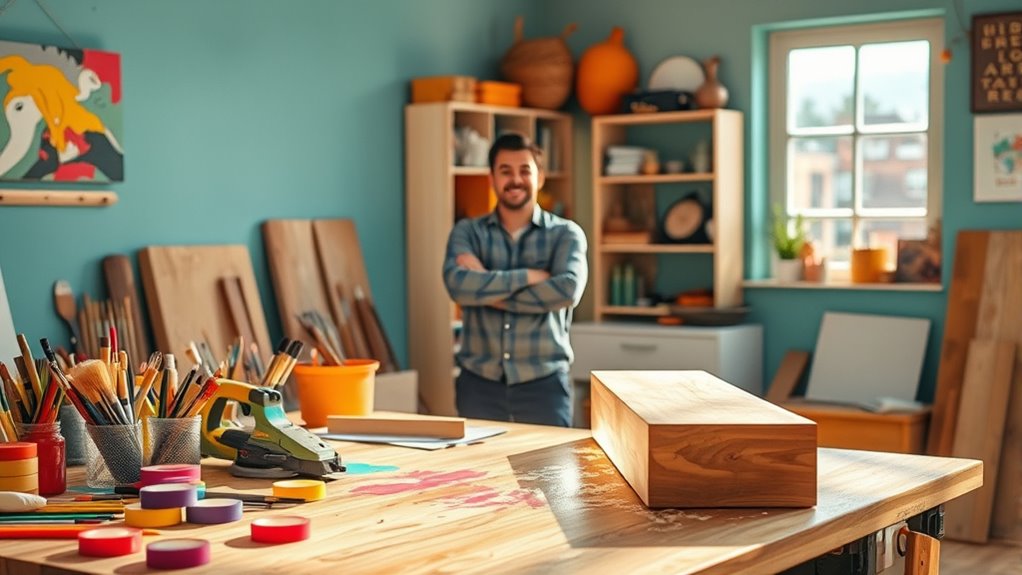
Celebrating success is essential for reinforcing teamwork and boosting morale. After completing your DIY project, take time to acknowledge your achievements together.
Organize a team recognition ceremony, where everyone receives awards and praise for their contributions. Consider fun group activities like escape rooms or even a mini dance party to bond and enjoy the moment.
Celebrate teamwork by hosting a recognition ceremony with awards, followed by fun activities like escape rooms or a mini dance party.
Social gatherings, such as meals or picnics, can also foster camaraderie. Capture the occasion with group selfies or victory poses, creating memorable keepsakes.
Don’t forget to share your success on social media or through internal channels, ensuring everyone knows about the hard work and dedication.
Frequently Asked Questions
What if I Lack Experience With DIY Projects?
If you lack experience with DIY projects, don’t worry! Start small with simple tasks that match your skill level, like painting a room or assembling furniture.
Gather resources, such as online tutorials and community forums, to guide you. Remember, everyone makes mistakes—embrace them as learning opportunities.
Set a realistic budget and timeline to keep things manageable. By taking action and gradually building your skills, you’ll gain confidence and enjoy the process.
How Do I Find Inspiration for My First Project?
When you’re standing in a treasure trove of creativity, inspiration surrounds you like a warm embrace.
Wander through high-end stores and let their exquisite displays spark ideas that dance in your mind. Explore Pinterest for a visual feast of DIY projects, or immerse yourself in blogs and YouTube tutorials for hands-on guidance.
Don’t forget to observe the beauty of historical architecture—it can add a timeless charm to your creations.
Your first project awaits!
Can I Collaborate With Friends on a DIY Project?
Absolutely, you can collaborate with friends on a DIY project!
Working together can boost creativity and make the process more enjoyable. You’ll share knowledge and skills, divide tasks for efficiency, and bond over your shared experience.
Just make sure to set clear goals, assign roles based on strengths, and keep communication open.
It’s a great way to learn, create something unique, and have fun while doing it!
What Should I Do if I Run Out of Materials?
Oh no, you’ve run out of materials mid-project! That’s like baking a cake without flour.
First, take a deep breath. Check your supply stash; you might find an alternative hiding in there.
If not, embrace that creativity! Visit local stores or search online for substitutes.
You could even simplify your design—who said DIY can’t be abstract?
Just remember, patience is key, and sometimes, a little flexibility can lead to unexpected masterpieces.
How Can I Ensure My Project Is Safe for Children?
To guarantee your project is safe for children, start by using non-toxic materials and providing proper safety gear like goggles and gloves.
Supervise closely, especially around tools and hot items. Keep your workspace organized and clutter-free to prevent accidents.
Explain safety rules clearly and assign age-appropriate tasks. Encourage kids to ask questions and learn about safe practices, building their confidence while you guide them through the project safely.
Conclusion
Now that you’ve got the essential tips for starting your first DIY project, you’re ready to plunge in. Remember, it’s all about choosing manageable tasks and enjoying the journey. So grab your tools and channel your inner artisan—after all, even the cavemen knew the joy of creating something with their own hands! Celebrate each little victory, and don’t forget to share your masterpiece with friends. Happy crafting, and may your projects be as legendary as a rock concert!

